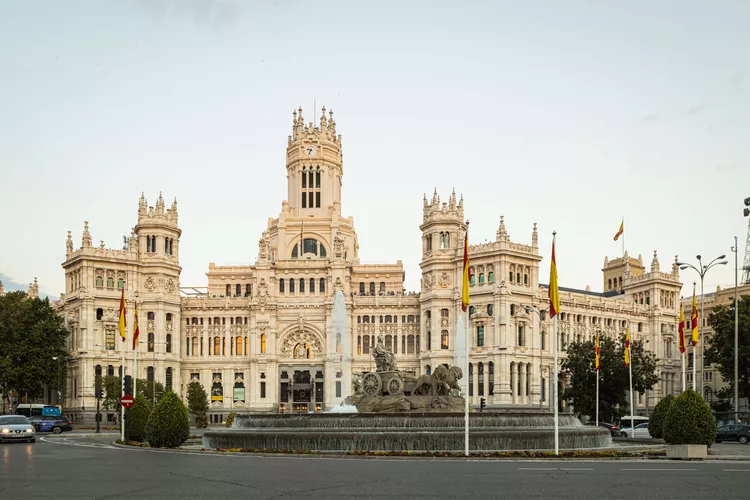Exploring Plaza de Cibeles in Madrid
As one of Madrid’s most emblematic and iconic squares, Plaza de Cibeles has become as much a symbol of the city as Puerta del Sol. The neoclassical square in central Madrid serves multiple purposes, from being a major traffic hub to hosting spectacular buildings and even an unofficial headquarters for Spanish soccer celebrations. Additionally, it boasts a rich history and cultural significance. Here’s what to know before you go.
History
The origins of Plaza de Cibeles trace back to 1777, with the construction of its first magnificent building, the Buenavista Palace. A few years later, in 1782, the square’s centerpiece, the Cibeles Fountain, was created. Originally outside the Prado Museum, it was moved to the plaza in 1895.
In the subsequent century, several notable buildings were established around this square. The Bank of Spain was completed in 1891, Linares Palace in 1900, and the stunning Cibeles Palace itself followed in 1919.
How to Get There
Plaza de Cibeles is ideally located in the heart of Madrid, at the junction of several key neighborhoods and thoroughfares. It sits at the intersection of Calle Alcalá and Paseo del Prado, making it easily accessible from almost any part of the city center.
Madrid is known for its walkability, thus reaching Plaza de Cibeles on foot from other major tourist sites is quite convenient. Alternatively, for those preferring public transportation, metro line 2 services the area, with the Banco de España station as the nearest stop. Various bus lines, including 1, 2, 9, 10, 15, 20, 34, 51, 52, 53, 74, 146, 202, and 203, also provide access to the square.
What to See at Plaza de Cibeles
Each of the four significant structures surrounding Plaza de Cibeles and the iconic fountain possesses its own unique story, contributing to Madrid’s rich legacy.
- Buenavista Palace: As the oldest building in Plaza de Cibeles, Buenavista Palace has noble origins, originally serving as a residence for the Duke and Duchess of Alba. Today, it functions as the headquarters for the Spanish Army. Guided tours are available, offering a chance to witness the fascinating changing of the guard on the last Friday of most months.
- Cibeles Fountain: The fountain, which lends its name to the square, depicts Cybele, the Greek goddess of fertility and nature, riding atop a chariot pulled by lions. This powerful symbol attracts both Real Madrid soccer team members and their fans during victory celebrations.
- Bank of Spain: The Banco de España building stands as the only structure in Plaza de Cibeles that continues to serve its original function. Its impressive exterior façade complements the artistic masterpieces housed within, featuring works from renowned artists like Goya.
- Linares Palace: Positioned on the northeastern corner of the plaza, Linares Palace was home to the noble Linares family in the early 20th century. It has since been restored and now operates as Casa de América, a cultural center dedicated to promoting the art and heritage of Latin America through various exhibitions and events.
- Cibeles Palace: After its completion in 1919, this stunning structure functioned as the headquarters for the national postal service and is often considered one of the most beautiful post offices globally. In 2007, it transitioned into Madrid’s city hall, and visitors can enjoy a rooftop terrace that offers delightful drinks and panoramic views of the city center.
What to Do Nearby
Thanks to its fantastic location, there’s an abundance of attractions near Plaza de Cibeles. Heading west will lead you to Gran Vía, Madrid’s most famed avenue, which conveniently connects you to Puerta del Sol.
To the south of the square lies two of the three iconic museums that create Madrid’s Golden Triangle of Art: the Prado and the Thyssen-Bornemisza Museums. Madrid’s most renowned green space, Retiro Park, is located just to the east, offering a perfect escape into nature.
Finally, venturing north will bring you into the upscale Salamanca district, recognized for housing some of Madrid’s finest shopping opportunities.





